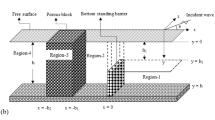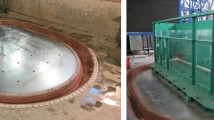Abstract
The marine structures in offshore area, such as composite breakwater, are generally vulnerable to the strong seismic wave propagating through their seabed foundation. There are a lot of failure examples during the strong earthquake events in the world in the past 20 years. However, attention given to the seismic response of marine structures under strong seismic wave is limited. In this study, taking the dynamic Biot’s equation “u − p” as the governing equation for porous seabed foundation, the seismic response of a composite breakwater and its porous seabed foundation under the seismic wave recorded in the Japan 311 off the pacific coast of Tohoku earthquake (M L = 9.0) is investigated using a FEM numerical model. The numerical results indicate that the seismic response of composite breakwater is very strong in the earthquake process. The amplification of the input seismic wave occurs both in seabed foundation and composite breakwater; and this amplification is positively related to the buried depth of points. The horizontal seismic response is much strong than the vertical seismic response. The seismic wave induced excess pore pressure and effective stresses in seabed foundation vibrates; the vibration amplitude is also positively related to the buried depth of points. Under strong seismic loading, the surface region of seabed foundation could liquefy. The parametric study shows that the young’s modulus of seabed foundation has significant effect on the seismic response of composite breakwater.
Similar content being viewed by others
References
Arablouei A, Gharabaghi ARM, Ghalandarzadeh A, Abedi K, Ishibashi I (2011) Effects of seawater-structure-soil interaction on seismic performance of caisson-type quay wall. Comput Struct 89(23–24): 2439–2459
Byme P (1991) A cyclic shear-volume coupling and pore-pressure model for sand. In: Proceedings of 2nd international conference on recent advances in geotechnical earthquake engineering and soil dynamics, vol 1.24, pp 47–55
Chan AHC (1988) A unified finite element solution to static and dynamic problems of geomechanics. PhD thesis, University of Wales, Swansea Wales
Chen B-F (2000) Dynamic responses of coastal structures during earthquakes including sedimentseastructure interaction. Soil Dyn Earthq Eng 20(5–8): 445–467
Chen B-F, Huang C-F (2002) Hydrodynamic forces on concrete sea wall and breakwater during earthquakes: effects of bottom sediment layers and back-fill soil. Ocean Eng 29(7): 783–814
Cihan K, Yuksel Y (2011) Deformation of rubble-mound breakwaters under cyclic loads. Coast Eng 58(6): 528–539
Iai S, Kameoka T (1993) Finite element analysis of earthquakeinduced damage to anchored sheet pile quay walls. Soils Found 33(1): 71–91
Jafarian Y, Alielahi H, Abdollahi AS, Vakili B (2010) Seismic numerical simulation of breakwater on a liquefiable layer: IRAN LNG port. Electron J Geotech Eng 15 D: 1–11
Katona MG, Zienkiewicz OC (1985) A unified set of single step algorithms. Part 3: the beta-m method, a generalisation of the Newmark scheme. Int J Numer Methods Eng 21: 1345–1359
Katopodi I, Iosifidou K (2004) Impact of the lefkada earthquake 14-08-2003 on marine works and coastal regions. In: Proceedings of 7th panhellenic geographical conference, Mytilene, Greece, pp 363–370
Kiara A, Memos C, Tsiachris A (2004) Some practical aspects on the seismic behavior of rubble-mound breakwaters. In: Ports 2001: America’s ports—gateways to the global economy—proceedings of the ports 2001 conference, vol 108, pp 1–10
Memos C, Bouckovalas G, Tsiachris A (2000) Stability of rubble-mound breakwaters under seismic action. In: Coastal engineering 2000—proceedings of the 27th international conference on coastal engineering, ICCE 2000, vol 276, pp 1585–1598
Memos C, Protonotarios JN (1993) Patras breakwater failure due to seismic loading. In: Proceedings of the coastal engineering conference, vol 3, pp 3343–3356
Memos CD, Kiara A, Pavlidis E (2003) Coupled seismic response analysis of rubble-mound breakwaters. Proc Inst Civ Eng Water Marit Eng 156(1): 23–31
Mohajeri M, Ichii K, Tamura T (2004) Experimental study on sliding block concept for caisson walls. J Waterw Port Coast Ocean Eng 130(3): 134–142
Newmark NM (1959) A method of computation for structural dynamics. J Eng Mech Div ASCE 85: 67–94
Okusa S (1985) Wave-induced stress in unsaturated submarine sediments. Geotechnique 35(4): 517–532
Ou J (2009) Three-dimensional numerical modelling of interaction between soil and pore fluid. PhD thesis, Universtity of Birmingham, Birmingham, UK
Ozaki R, Nagao T (2004) Verification of seismic stability of caisson type breakwater. In: Proceedings of the 13th world conference on earthquake engineering. Paper no. 0588
Sugano T, Kaneko H, Yamamoto S (1999) Damage to port and harbor facilities. The 1999 Ji-Ji earthquake, taiwan, investigation into the damage to civil engineering structures. In: Japan Society of Civil Engineers, chap 5, pp 51–57
Sumer BM, Ansal A, Cetin KO, Damgaard J, Gunbak AR, Hansen NEO, Sawicki A, Synolakis CE, Yalciner AC, Yuksel Y, Zen K (2007) Earthquake-induced liquefaction around marine structures. J Waterw Port Coast Ocean Eng 133(1): 55–82
Sumer BM, Kaya A, Hansen ONE (2002) Impact of liquefaction on coastal structures in the 1999 Kocaeli, Turkey earthquake. In: Proceedings of the international offshore and polar engineering conference, vol 12, pp 504–511
Tsai CP, Lee TL (1995) Standing wave induced pore pressure in a porous seabed. Ocean Eng 22(6): 505–517
Westergaard HM (1933) Water pressure on dams during earthquakes. Trans ASCE 98(2):418–433
Wyllie LA (1986) The chile earthquake of March 3, 1985. Earthq Spectra 2(2): 293–371
Young Y, White J, Xiao H, Borja R (2009) Liquefaction potential of coastal slopes induced by solitary waves. Acta Geotechnica 4: 17–34
Yuksel Y, Cetin KO, Ozguven O, Isik NS, Cevik E, Sumer BM (2004) Seismic response of a rubble mound breakwater in Turkey. Proc Inst Civ Eng Marit Eng 157(4): 151–161
Zienkiewicz OC, Chan AHC, Pastor M, Schrefler BA, Shiomi T (1999) Computational geomechanics with special reference to earthquake engineering. Wiley, England
Zienkiewicz OC, Chang CT, Bettess P (1980) Drained, undrained, consolidating and dynamic behaviour assumptions in soils. Geotechnique 30(4): 385–395
Author information
Authors and Affiliations
Corresponding author
Rights and permissions
About this article
Cite this article
Ye, J. Seismic response of poro-elastic seabed and composite breakwater under strong earthquake loading. Bull Earthquake Eng 10, 1609–1633 (2012). https://doi.org/10.1007/s10518-012-9365-8
Received:
Accepted:
Published:
Issue Date:
DOI: https://doi.org/10.1007/s10518-012-9365-8




